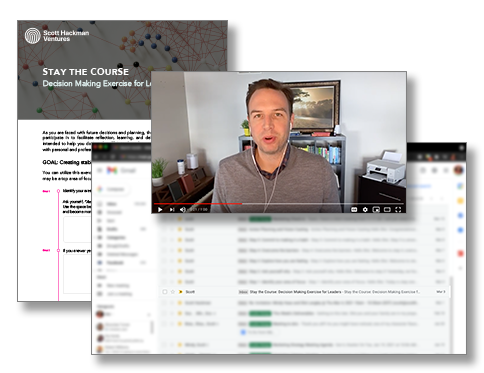How vulnerability reveals blind spots and how courage is a muscle we can flex to build trust.
Taking the temperature of your team:
Are you noticing division and reserved communication between your team members? When expectations are misaligned, it becomes remarkably challenging for team members to stay engaged, perform tasks well, and solve problems across functional groups.
The same goes for boundaries—if leadership and team members aren’t naming their strengths/weaknesses, what they want, and how they will contribute to the end goal, gaps form and alignment can’t happen. Naming expectations and boundaries will feel uncomfortable because this type of action requires a remarkable amount of emotional literacy, inner calm, and mental resilience.
This is a challenge and the end result is well worth it for most people. In fact, continuing to foster an environment without trust and vulnerability has traumatic long-term consequences. When the future is uncertain, chemical reactions occur in our brains, and many feelings of fear, anger, and anxiety emerge. We need to recognize the feelings by accurately labeling them with articulation and appropriate expression in order to get to the other side of the emotion. This is when we can access the thinking part of our brain. When this process is short circuited and unable to happen interpersonally within a group or internally as a human; often times people withdraw and reserve their thoughts and feelings toward a situational problem that is attempting to be solved. Do you see this happening within your teams?
As their leader, you can stop this block and emotional cycle by beginning the process of building trust through vulnerability. This can be accomplished by showing up as a human with thoughts and feelings that can be accurately labeled and appropriately expressed. You can also access your courage to name why it is hard to trust the process when the outcome is unclear. Openly communicate how you need help from each member of the group and the positive impact it makes when they show up fully engaged, unafraid of being wrong and prepared to present their best thinking.
Why vulnerability is good for business:
Vulnerability is the foundation of trust, and trust is the foundation of effective communication—both of these lead to better decision making and joint commitment to a vision. For example, if business partners can speak openly about what they want, they can tie their personal values and goals to the values and goals of the company, this is intrinsically motivating and energizing. Naming what you want and how you want to contribute to the organization is incredibly vulnerable while accepting that you may not get what you want requires courage and the ability to see another possibility .
Allowing room for transparent and open discussion can help people feel safe to name the root issue and problems that are getting in the way of engagement and performance. With the root issues identified, and the group of people willing and able to align around steps to solve the problem, the overall organization will improve. As a result, this will be measured in overall happiness, internal advancement, increased engagement and performance. When you practice building these muscles and leadership skills, you begin to model a high level of leadership thinking and as a result, you will inspire positive change, personal growth, and group collaboration and innovation.
Building a vulnerable and trusting team:
The ability to build a vulnerable and trusting team begins with the leader’s commitment to:
· Lead by example through open and honest conversations and role modeling when it gets tough during a hard dialogue where feelings are at stake.
· Listen without predetermined judgements and showing forth genuine curiosity will serve to activate questions in the thinking brain, allowing for the greatest potential in the people to emerge.
Set aside time on a regular basis with each of your team members and get to know them. Begin having significant conversations about who they are and how that is aligned with their values and goals of their roles in the organization. You may notice that opportunities will emerge to role model and to build emotional intelligence during hard conversations—embrace this as it will naturally develop trust over time. Knowing your team on a personal level, understanding their desires, needs and vision, will empower them to openly name their truer thoughts and feelings about a goal or problem resulting in better paths forward.
Putting it into Action:
- As the leader of the organization, be present in meetings and hold 1:1’s with each employee, creating time to identify how members want to contribute to a goal. Describe how building trusting relationships are hard, ask them what the best working relationship looks like for them and how they can see themselves contributing more to the goals of the organization. Last but not least, inquire about how that work is aligned with their values.
- Acknowledge when you don’t know how to solve a problem or reach a goal. Share your work and make it visible so that everyone is aware of the effort and challenges you have already faced as well as obstacles you’ve overcome.
- Ask for input based on their strengths and areas they are working to improve. Solicit feedback on your team and from your team in team meetings. Evaluate together what’s working and what’s not effective in serving internal stakeholders and reaching goals in roles.
Additional Support:
Often, these teams can benefit from having a third party opinion. This is where I come in. I’m often sought to help around mission-critical changes, transitions and decision points to help all parties come into alignment. How do we develop talent and leadership so that succession can happen in the future? My role is not to solve the problem in isolation, but to guide the conversation and decision-making process that leads to planning, doing, reflecting, improvement, engagement, and actions to practice. The goal is to get everyone working towards a shared vision with clarity, confidence and enjoyment.
Build the necessary momentum for your business to thrive by creating a team founded on vulnerability and trust.


Scott Hackman is the Founder and CVO of Scott Hackman Ventures. He has over 15 years of experience in business advising, coaching, and leading growth through transitions.
Meet Scott.



